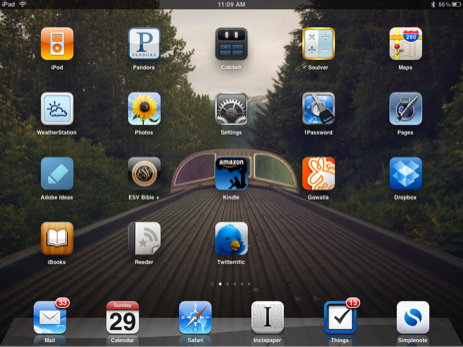A lot of great software shipped in the past 12 months. There were many new apps for the iPhone and iPad, and many great updates to some already stellar Mac apps.
Here is my list of the best software that shipped in 2010. These are apps I use regularly and which were brand new or received an X.0 update at some point in 2010.
OmniFocus for iPad
OmniFocus for iPad was released in July. It is, without a doubt, the best of the three-app suite of OmniFocus software.
It seems to be a common practice that for apps with a strong presence on the desktop, their iPhone and iPad counterparts are portals, or lighter versions, of their desktop apps. Not so with OmniFocus on the iPad; it is the current king of the OmniFocus hill. Moreover, it is one of the most robust, feature-rich, easy-to-use apps on my iPad.
The two most-addicting features of OmniFocus on the iPad are the review and the forecast views. This app is one of the few which have justified my iPad purchase.
Reeder
Reeder for iPhone 2.0 and Reeder for iPad are my two preferred apps for reading feeds. When Reeder 2.0 shipped in March it answered all of my quibbles about what I wanted from an iPhone Feed Reader.
Reeder for iPad, shipped in June, and it is superb. I enjoy the UI and the top-notch readability it presents. By far, my favorite feed reading app for the iPad.
Canned
Canned is an iPhone app that came out in August. I had the privilege of helping Sky Balloon beta test it, and it’s been on the front of my iPhone Home screen ever since.
Canned lets you pre-write the content of those text messages you send often, and even pre-assign those to the individuals and groups whom you often send that same text to.
I used to have a folder in Pastebot for these types of texts, but Canned is much better suited for the task. The app is simple and blazing fast. Buy it in the App Store for the price of a soda.
Instapaper Pro for iPad
If there ever was a piece of software that was like a good cup of coffee it would be Instapaper. Unlike other software and services where describing the ins and outs and use-cases gives others a very good understanding of the product, Instapaper is much too simple for that.
So in short, Instapaper is the best way to read the Internet. And the iPad app (which launched in April) is the best way to read your Instapaper articles.
And, if you want to get my starred articles in your Instapaper queue, my username is “shawnblanc”.
MarsEdit 3.0
MarsEdit is one of the most-used, most-important, and most-beloved applications I own. I can’t imagine writing shawnblanc.net without it. Version 3.0, which was released in May, added quite a few features to an already rock-solid application.
A highlight feature of the 3.0 release for many was the WYSIWYG editor. However, the most notable for me was the added support for WordPress custom fields, which — when combined with this Linked List plugin — makes posting links on my site a breeze.
Simplenote 3.0
Simplenote is an iPhone and iPad app that offers a minimalistic writing and note-taking interface and over-the-air syncing. Version 3 shipped in August, and is the sort of app adored by those who pride themselves in their use of beautiful and uncomplicated software.
Simplenote is also an app for people with ideas. It’s for those who need some way to jot an idea down, build on it, and refine it until they’re sick and tired of it, regardless of where they are or if they brought their laptop.
And as a writer, Simplenote could very well be your principal writing app. It has a straightforward design that makes it effortless to use. In Simplenote there is no text formatting, it’s just plain. There is no document titling — when you create a new note, the first line is the title. There is no saving a note — you just write and your note is backed up in real time, and even synced with any other other devices you use: iPad, iPhone, and Mac.
Dropbox 1.0
The most common misconception about Dropbox is that it’s solely for file syncing between multiple computers. Well, I only own one computer and I use Dropbox all day long.
Because Dropbox syncs your files to the Web, I use it to keep all folders for my current projects. This means things I am working on at the present moment are always backed up to the Web.
Also, by using Symlinks, I have the Application Support Folder for my most-used apps (MarsEdit, Yojimbo, 1Password, OmniFocus) sitting in Dropbox as well. Which means if I didn’t back up my laptop for a week or two, chances are good I would hardly lose anything important. And if I drop my laptop out the car window on the way home from work, I for sure wouldn’t lose anything from the day.
Dropbox finally hit version 1.0 in December, adding some stability issues and, most notably, options for selective syncing of folders.
Instagram launched in October and by the end of 2010 had over 1,000,000 users. It’s part iPhone app, part social network, all fun.
It’s an iPhone-only app that works somewhat like Twitter but with photos. You take a quick snapshot, apply a filter, and share it with your followers. You can also send those photos to your Flickr, Tumblr, and/or Posterus accounts, as well as sharing them on Twitter and Facebook.
Instagram is low friction, and high-fun. And now that Twitter displays Instagram Media inline, it’s not unlike using TwitPic to post photos to your Twitter account. You can find me on Instagram as “shawnblanc”.









